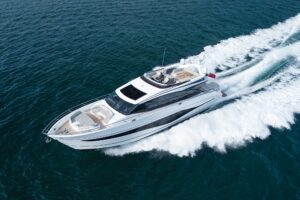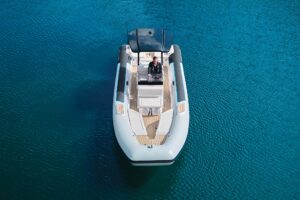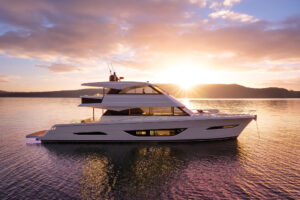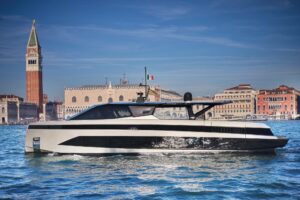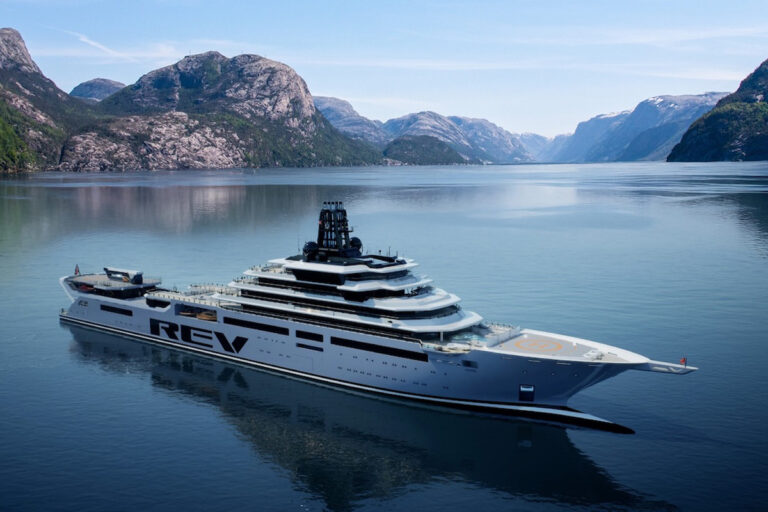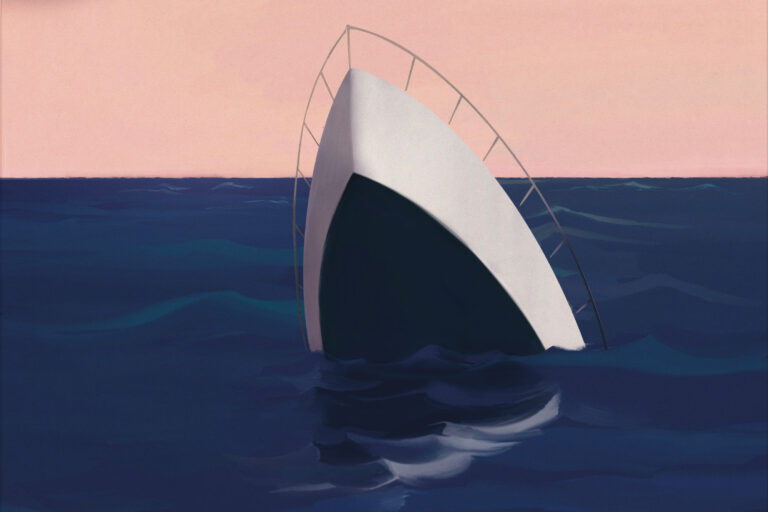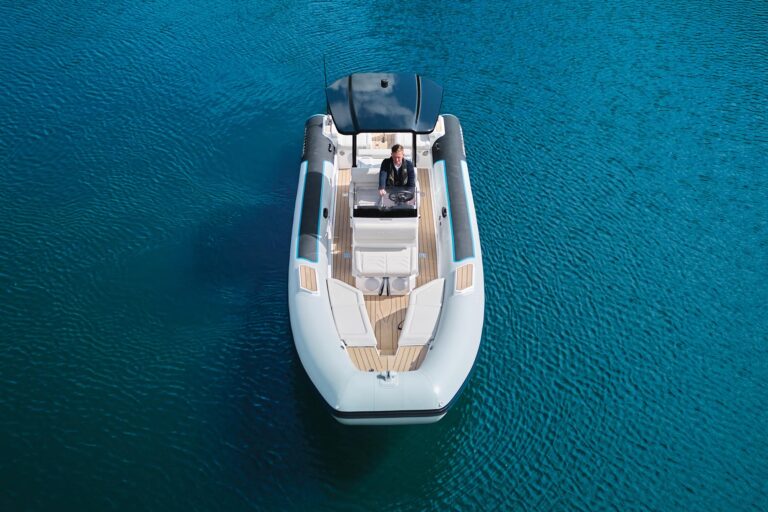Hatteras is red hot these days. Recent additions to the company’s fleet, including the 70 and 60 Convertibles, have enabled the production builder to manufacture first-class tournament fishing machines comparable to the best custom-built boats anywhere. It’s no wonder there’s a waiting list. And with the introduction of the 55 Convertible, the youngest Hatteras is poised to eat up the wakes of its larger siblings.
I fished aboard the 55C two days during Shootout XX in May in Marsh Harbour, Abaco, Bahamas. Though I’ve also fished the 70C and 60C, I was still moved by the way the New Bern, North Carolina, builder improves and tweaks its designs.
The 55C takes over for the popular 54 Convertible, and while replacing a proven war horse is always a cause for jitters, the 55C steps up to the plate with the alacrity of a lead-off hitter destined to get on base with a sharp line drive.
A smart move by the 55C is borrowing elements from the running surface of the 54C. Having tournament fished a 54C in hellish seas, I believe the most crucial aspect of any offshore boat is having plenty of meat under my soggy Top-Siders. So combining her 70,000 lb. half-load displacement with an eight-degree transom deadrise, the 55C clearly demonstrates the Hatteras mantra that form must follow function. Modest propeller pockets keep the draft at 5-feet 4-inches and allow the familiar deep gearing that Hatteras has pioneered to deliver tractor-like resolve from its 3.45:1 ratio. In deep water, I recorded a top speed of 33 knots on the GPS in 4-foot seas with seven people, full cruising and fishing gear, and 1,100 gallons of fuel aboard. Sure, there are lighter boats that are faster than the 55C, but speed is not enough to coax me aboard them out at the 1,000 fathom curve when the wind starts screaming. The 55C represents four decades of evolution, and it’s reassuring to know that every time you leave the dock, 40 years of experience is riding right along with you.
The 55C also makes use of many engineering and design traits found aboard the 60C and 70C, including frameless side windows and the curvy flying bridge wings and extended deck. Power steering is standard, and it’s a gas to throw this beast into a hard over turn with one finger. Helm response is a quick 3 1/2 revolutions, lock-to-lock. The command console is a center pod affair with single lever controls and solid detents you can feel with your eyes closed. Our test boat also had the optional ($30K) Caterpillar Engine Vision System, which incorporates gauge and diagnostic displays. The 8- by 6-inch Star Wars screen is filled with LCD multi-colored bezels that report vital engine functions, but they literally hold the dash hostage by taking up too much space. Plus, the gauges are small and difficult to read at a glance and the steering wheel partially blocks the bottom row of instrumentation from view. In the enclosed wheelhouse of a Hatteras motoryacht, this optional display package would look good. But on an open bridge, I wasn’t impressed. To put it into perspective, the VDO fuel gauges on the dash are only slightly smaller than the tachs, and larger than all the other gauges. The idea behind the center pod helm is to minimize clutter and simplify engine monitoring, so I’d recommend analog gauges in this application.
The 9-feet long by 13-feet wide cockpit represents state-of-the-art tournament fishing requirements from the transom door to the stowage compartment, beneath the saloon steps for the chamois and mop handles. The portside features a bait and tackle center, which houses an insulated sink, cut board and equipment drawers, drop-in bait freezer and engineroom access. Toe steps allow hand-free openings. Starboard of the saloon door is a deep locker where the optional livewell fits. The 6- feet 2-inches long by 1-foot 8-inches wide by 1-foot 6-inch deep fishwell under the nonslip sole can be refrigerated and outfitted with a macerator pump as an additional option. The transom fishbox aboard the test boat was equipped with an optional Eskimo shaved icemaker fed from a watermaker abaft the port engine.
The reach to the waterline is a comfortable 3-feet 5-inches and the cockpit depth from the sole to the top of the coaming is 2-feet 4-inches. Locking hatches flank the fishwell for lazarette access. Polyurethane paint in the bilge provides a glossy finish that’s easy to keep clean. Vibration dampers in the lazarette contribute support to the deck and absorb mechanical and water noise from transmitting to the cockpit sole. These devices and the side exhausts contributed to pleasant sound and modest vibration levels at all engine settings. At trolling speeds, for example, dbAs on the bridge and in the cockpit were 71 and 72, respectively. When Hatterascal skipper Capt. Terry Stansel called down from the helm in conversational tones to Capt. Daryl Brower in the cockpit, I could hear every word, and I was sitting on the tackle center beneath the flying bridge overhang. At 2100 rpm, noise levels on the flying bridge were 89 decibels.
The engineroom has 5-feet 8-inches headroom on centerline and more than enough space to get around the front of the Caterpillars to reach the outboard sides without breaking a sweat. Despite the volume of equipment, there is an order to the mechanical systems that makes maintenance less than a chore from the well-marked through-hull fittings on down to the a.c. fan that moves out waste heat as quickly as ice melts in the Bahamas. Bright white paint and dual-voltage lighting eases the burden on older eyes.
Two interior and flying bridge arrangements are offered. Differences can be seen in the galley, with a choice of undercounter slide-out Sub Zero refrigeration, or a standup unit; and in the forward stateroom berths. The standard bridge has electronic stowage to starboard, while the optional arrangement aboard the test boat offers the pop-up console.
Tournament bred and solidly built, the 55C represents an excellent fit in the Hatteras roster and a worthy successor to the popular 54C.
Contact: Hatteras Yachts, (252) 633-3101; www.hatterasyachts.com.

